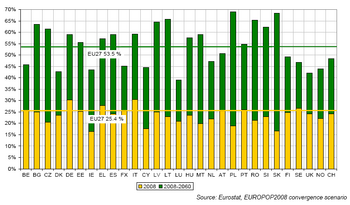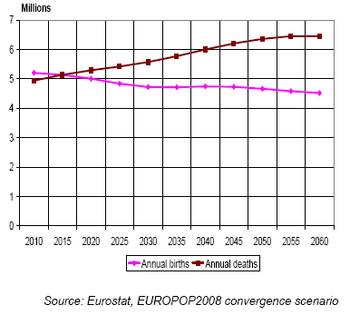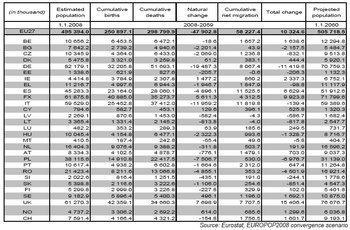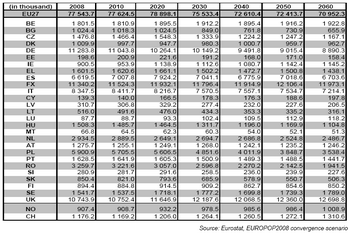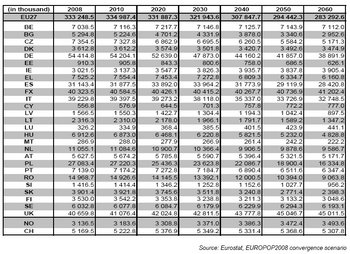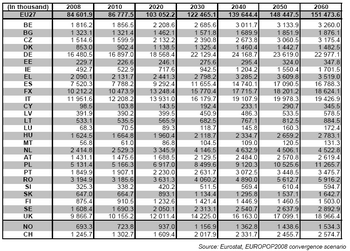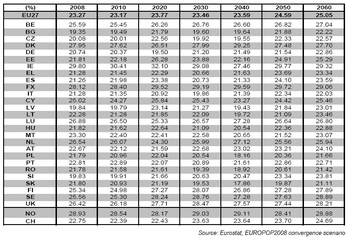Archive:Population projections
(Data from June 2008)
Population projections are what-if scenarios that aim to provide information about the likely future size and structure of the population. Eurostat’s population projections (EUROPOP2008) convergence scenario is one of several possible population change scenarios based on assumptions for fertility, mortality and migration. In particular, the assumptions have been developed in a conceptual framework of convergence of demographic values as a result of decreasing socio-economic and cultural differences between the Member States of the European Union (EU), Norway and Switzerland.
The current scenario is primarily used in the context of the European Commission’s analysis of the impact of ageing populations on public spending.
Main statistical findings
The 2008-based national population projections
EUROPOP2008 convergence scenario show the
population of the EU-27 rising gradually from
495.4 million in 2008, reaching 520.7 million in 2035 and
thereafter gradually declining to reach 505.7 million on
1st January 2060.
The EU-27 population is projected to become older with the median age projected to rise from 40.4 years in 2008 to 47.9 years in 2060. The share of people aged 65 years or over in the total population is projected to increase from 17.1% to 30.0% and the number is projected to rise from 84.6 million in 2008 to 151.5 million in 2060. Similarly, the number of people aged 80 years or over is projected to almost triple from 21.8 million in 2008 to 61.4 million in 2060. The young age dependency ratio for the EU-27 population is projected to rise moderately to 25.0% in 2060, while the old age dependency ratio is expected to increase substantially from its current levels of 25.4% to 53.5% in 2060. Whereas in 2008 in the EU-27 there are 4 persons of working age (15-64 years old) for every person aged 65 years or over; in 2060 the ratio is expected to be 2 to 1.
Countries are projected to follow different population change trajectories
Although the EU population is likely to be 2.1% higher on 1st January 2060 compared to 1st January 2008, there is considerable variation between the Member States. As Figure 3 shows, fourteen Member States are projected to have a smaller population on 1st January 2060 than to 1st January 2008. From these countries, Bulgaria, Latvia, Lithuania, Romania, Poland, Estonia and Hungary are projected to follow a decreasing trajectory for their population over the whole projection period 2008-2060. The other Member States, Norway and Switzerland are projected to have a higher population on 1st January 2060 than on 1st January 2008. Particularly, the total populations of Cyprus, Ireland, Luxembourg, Norway, the United Kingdom, Switzerland, Sweden, Metropolitan France, Belgium and Denmark are projected to follow a continuously rising trajectory over the whole projection period. The projected changes of the total population in 2060 compared to 2008 have a moderate impact on the Member States’ shares in the EU-27 population.
Population ageing is a generalised process The population is projected to become older in all Member States, Norway and Switzerland. Thus the median age of the total population is likely to increase in all countries without exception due to the combined effect of the existing structure of the population, persistently low fertility and continuously increasing number of survivors to higher ages. As Figure 4 shows, over the whole projection period 2008-2060, the median age is projected to increase more than 15 years in Poland and Slovakia. In contrast, the median age is projected to increase less than 5 years in Luxembourg, the United Kingdom, Denmark, Metropolitan France, Sweden, Belgium and Finland. The ageing process is also visible in the structure of the projected population. The share of the population aged 65 years or over (Table 10) is projected to increase in all countries. It should be noted that in only 6 countries is the increase projected to be less than 10 percentage points. In particular, the population aged 80 years or over is projected for all countries to increase in relative (Table 11) as well as absolute terms (Table 6). Population pyramids show the population distribution by sex and usually by single year of age or year of birth. Each bar corresponds to the share of the population at that age, by sex, in the total population. As Figure 5 shows, the population for the EU27 continues to age. The 2008 population pyramid appears more as a rhomboid due to the baby boomer cohorts of the 1960s which are significant on account of their size. In the coming decades, the high number of ageing baby boomers will swell the number of elderly. Thus, this population pyramid for the EU27 shows how the baby boomer bulge is moving up while the middle part (working age population, ages 15-64) and the base (ages 0-14) of the pyramid are projected to narrow considerably by 2060.
Trends in the projected age dependency ratios
The age dependency ratios are used as indicators of the level of support of the young (aged 0-14 years old) or of the old (aged 65 years or over) by the working age population (conventionally aged 15-64 years old). They are expressed in terms of the relative size of the young or the old age population to the working age population. In 2060, for the EU27 as a whole, the working age population is projected to be smaller by almost 50 million persons (Table 4) compared to 2008. Over the same projection period the population aged 65 years or over is projected to increase by almost 67 million persons (Table 5). As a result, the old age dependency ratio in 2060 for the EU27 is projected to more than double from its current level. That represents an increase of 28.1 percentage points by 2060. Two-thirds of the countries are expected to experience a decrease of different levels in their working age population. Combined with the general increase of the population aged 65 years or over, the old age dependency ratio in 2060 varies among countries by almost 30 percentage points from the lowest to the highest; in 2008 the difference was 14 percentage points. Therefore, as Figure 6 shows, although the old age dependency ratio increases for the whole group, individual countries are affected differently. In 2008, the old age dependency ratio in the new Member States [1] is, relatively, lower or much lower than the EU27. By 2060, with the exception of Cyprus, all new Member States are projected to experience higher increases in old-age dependency ratios than the EU27 as a whole i.e. 28.1 percentage points. Thus these countries, are expected to have old age dependency ratios higher than the EU27 and among the highest from the whole group of countries. In contrast, the young age dependency ratio (Table 7) is expected to follow a trajectory of small changes for all countries, either positive or negative. It is not expected to decrease significantly because the working age population – the parents’ generation – shrinks as well. The maximum increase is projected for Slovenia (+4.0 percentage points) with the maximum decrease being projected for Slovakia (-0.7 percentage points). Consequently the trajectory of the total age dependency ratio is shaped by the prevailing rise in the old age dependency ratio for all the countries.
Trends in the projected vital events and migration
As a result of below replacement fertility for all the countries, smaller cohorts of women reaching the reproductive age result in fewer births than in the past.
Thus for the EU27, the annual number of births is projected to decrease over the projection period 2008- 2060. At the same time the annual number of deaths is projected to continue rising. It is projected that from 2015 onwards (Figure 7), births will not outnumber deaths and hence population growth due to natural increase will cease. For this reason positive net migration will be the only population growth factor. However, as Figure 8 shows, it will not be possible in the long run to counterbalance the negative natural change.
Data sources and availability
Methods and concepts
The EUROPOP2008 “convergence scenario” is based on the population on 1st January 2008, and the assumptions have been developed in a conceptual framework where the socio-economic and cultural differences between Member States of the European Union would fade away in the long run. If the narrowing of differences concerned the demographic drivers, then this assumption would imply a convergence of demographic values. Consequently, in the convergence year 2150, fertility is assumed to converge to levels achieved by Member States that are considered as forerunners in the demographic transition. Life expectancy increases are assumed to be greater for countries at lower levels of life expectancy and smaller for those at higher levels, thus following convergent trajectories. Migration is assumed to converge to zero net migration in 2150. Additionally, migration in each country has been adjusted upwards if the working age population, after taking into account the converging migration, presents a deficit for the respective projection years. These assumptions can be summarised by means of indicators such as total fertility rate (TFR), life expectancy at birth and net international migration for the target year 2060. The latter is expressed as the share of the cumulative net migration over the whole projection period 2008-2060 in the total population on 1st January 2061. Alternative assumptions in a different conceptual framework, as for example the trend scenario, would yield different results.
Remarks concerning the jump-off population
The population for the 1st January 2008, is based on the latest available estimates produced by the National Statistical Institutes for BE, BG, DK, DE, ES, FX, IT, CY, HU, NL, AT, PL, PT, SI, FI, SE, UK, NO and CH. For CZ, EE, IE, EL, LV, LT, LU, MT, RO and SK estimates based on the latest Eurostat population nowcast have been used. Thus minor differences may be observed with data from official sources released at a later date.
Calculation of the age dependency ratios
The old age dependency ratio is calculated by dividing the population aged 65 years or over by the working age population (15 -64 years old) and expressed in per cent. The young age dependency ratio is calculated by dividing the population aged 0-14 years old by the working age population and expressed in per cent. The total age dependency ratio is calculated as the sum of the two other dependency ratios.
Context
<context of data collection and statistical results: policy background, uses of data, …>
Further Eurostat information
Publications
Main tables
- Title(s) of second level folder (if any)
- Title(s) of third level folder (if any)
Database
- Title(s) of second level folder (if any)
- Title(s) of third level folder (if any)
Dedicated section
Other information
<Regulations and other legal texts, communications from the Commission, administrative notes, Policy documents, …>
For other documents such as Commission Proposals or Reports, see EUR-Lex search by natural number
External links
See also
Notes
- ↑ Member States which acceded the European Union on 1/5/2004 and 1/1/2007.




